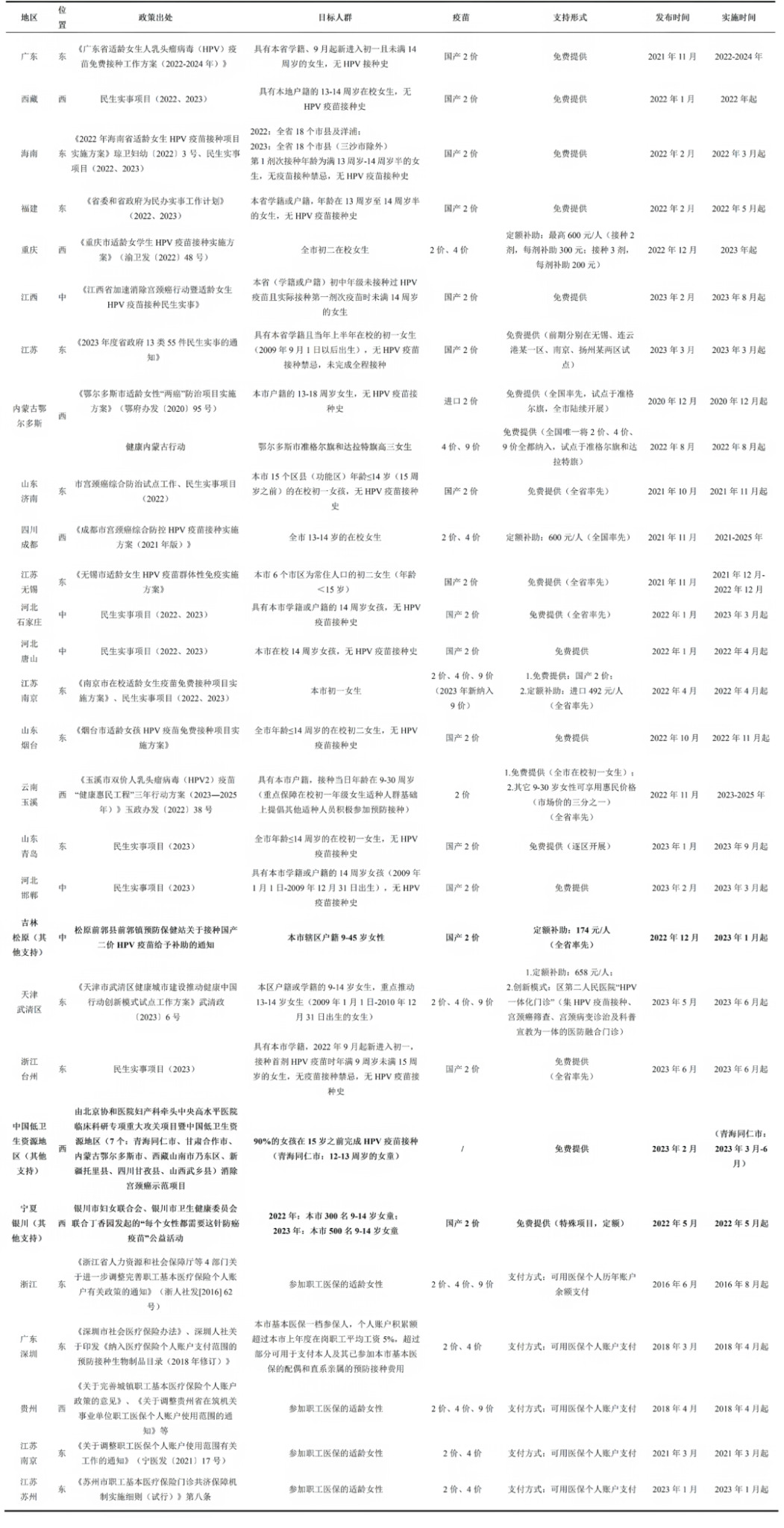Journal Content Recommendation
01
Effect of vaccine hesitancy on female college students’ willingness to receive the HPV vaccine in China: a multicenter cross-sectional study
The purpose of this study, which was published in BMC Public Health, was to examine the variables impacting female college students’ vaccination hesitation about HPV vaccination intentions in Chinese higher vocational colleges and universities to encourage the vaccination of this population. From September to October 2022, “a convenience sampling method was used to conduct a questionnaire survey among freshman female students from four higher vocational colleges in Henan Province, China.” The study matched vaccine-hesitant students with non-vaccine-hesitant students at a 1:1 ratio by the propensity score matching (PSM) method and then assessed the effect of vaccine hesitancy on HPV vaccination intention among female higher vocational college students by using univariate and multivariate logistic regression analyses.
The results showed that the prevalence of vaccine hesitancy among senior female college students was 44.75%, 82.9% of whom expressed a willingness to receive the HPV vaccine. Multifactorial ordered logistic regression analysis showed that vaccine hesitancy was a risk factor influencing female college students’ readiness to receive HPV vaccination [OR = 4.38, 95% CI: 2.74-6.99, P < 0.001]. In addition, students’ major (nursing vs. non-nursing) (P = 0.01) and independent acquisition of HPV vaccine-related knowledge (P = 0.04) were also significant factors influencing vaccination intentions.
Studies have shown that “Non-vaccine-hesitant students were more likely to be willing to receive the HPV vaccine than vaccine-hesitant students.” Therefore, it is recommended that healthcare providers and educators “focus on vaccine attitudes among female college students to reduce vaccine hesitancy and enhance community education on cervical cancer, HPV infection and prevention through multichannel campaigns.”
https://doi.org/10.1186/s12889-024-19303-1
02
One size does not fit all- Strategizing the vaccine supply chain in developing countries
This study is published in Operation Management Research. The study takes the case of the poliovirus eradication program in multiple vaccination districts of Pakistan, and based on the arcs of supply chain integration and the customer-facing (CF-SCI) theoretical model, the study analyzes the strategies to maximize vaccine accessibility by strengthening the demand side.
First, the study identifies fourteen vaccination-related factors from the literature that influence supply chain responses. Experts conducted validation, and eleven influencing factors were included in the study. These factors were then ranked and prioritized using the graph theory approach (GTA) and classified into three different strategy tiers of the CF-SCI model. The research team then used the mathematical model to separate the various immunization regions, adjusting the CF-SCI approach tiers accordingly.
The study showed that Tier 1 integration strategies comprise “accurate demand forecasts, controlling wastage, and enhancing synchronization among vaccination and other health services.” Tier 2 integration strategies comprise “a mix of centralization and de-centralization, coordination, and robust information systems, considering the relocation of vaccination centres to population epicentres.” Tier 3 integration strategies comprise “increased investment in awareness programs, increasing partnerships with private partners, and ensuring the well-being of personnel and ground support staff.” Finally, the conclusion, limitations, and future recommendations are provided. Solutions include increasing funding for polio program advocacy, expanding partnerships with the private sector, and ensuring the safety of vaccinators.
https://doi.org/10.1007/s12063-024-00479-z
03
Latin America is catching up on HPV vaccination and screening
This study was published in the BMJ. In low- and middle-income nations, the incidence of cervical cancer is still high, even with the availability of a safe and effective vaccine. According to the World Health Organization’s (WHO) 2018 launch of “the elimination of cervical cancer”, 94% of cervical cancer deaths worldwide will still occur in these areas by 2022, especially in Latin America. Using a thorough literature analysis and field survey, this study evaluated the state of HPV vaccination in Latin America and its progress.
The findings show that despite the disruption of HPV vaccination caused by the COVID-19 pandemic, HPV vaccination rates “have since recovered, to about 48% in 2023” and are expected to continue to rise. The use of gene sequencing technologies in HPV testing and self-testing techniques, which involve examining vaginal swabs obtained from women, has led to a notable rise in screening rates. Newly introduced thermal ablation technology devices, which are inexpensive and easy to use, have been “rolled out to 1.5 million women in 14 countries in Asia” and have significantly improved treatment outcomes. To increase screening rates, the study recommends expanding the promotion of single-dose vaccination strategies and providing everyone with access to gene sequencing-based HPV testing equipment and self-testing techniques. At the same time, more should be done to promote thermal ablation devices so that women can receive prompt, efficient care, laying a solid foundation for the eventual elimination of cervical cancer.
https://doi.org/10.1136/bmj.q1553
04
Pediatric Pneumococcal Conjugate Vaccine and Dosing Schedule Perceptions Among Health Care Providers and Caregivers in Germany, France, Spain, and Greece
This study was published in Infectious Diseases and Therapy. Even though the majority of European countries’ National Immunization Programs (NIPs) advise using pneumococcal conjugate vaccines (PCVs) that cover “10-15 serotypes administered in a three-dose schedule” (2+1, i.e., two doses of the base immunization plus a booster), a new PCV (PCV20) that covers 20 serotypes has just been licensed in Europe. Recently permitted in Europe, serotypes (PCV20) require a four-dose vaccination schedule (3+1). Using an online questionnaire, the present study collected the opinions and perceptions of 601 healthcare providers (HCPs) and 1,954 child caregivers from Germany, France, Spain, and Greece to understand their perceptions toward this new PCV and its vaccination regimen.
According to the survey results, “Nearly all HCPs (93%) agreed that broader serotype coverage against pneumococcal disease for children is a significant unmet need, and 92% had a “sense of urgency” to vaccinate children.” As long as serotype coverage was at least 20% higher than it is now, HCPs and caregivers were generally in favor of adding a dose of PCV and an extra clinic visit to the present level of coverage—at least 20% more coverage than there is now. Caregivers strongly agreed with the importance of full PCV vaccination, “even if it required co-administration with current vaccines or the introduction of a new office visit.”
The results showed that HCPs and caregivers were “virtually unanimous in their support for a PCV with broader serotype coverage and showed a subsequent willingness to include an extra infant dose/visit.” The report suggests promoting the new PCV, covering 20 serotypes, and adapting the vaccination program to each country’s situation.
https://doi.org/10.1007/s40121-024-01022-0
05
Use of a Financial Incentive Code for In-Home COVID-19 Vaccination of Homebound Older Adults
This study was published in JAMA. As the COVID-19 epidemic continues, older adults, especially those with mobility impairments, face serious health risks due to their high vulnerability and chronic conditions. Many homebound adults have difficulty accessing vaccines, which are most often administered at pharmacies and medical clinics.
The Centers for Medicare and Medicaid Services (CMS) are implementing the Healthcare Common Procedure Coding System (HCPCS) code M0201 in 2021, which augmented the reimbursement by $35 when taking in-home COVID-19 vaccination. The study’s objectives were to evaluate the use of home-based COVID-19 vaccination after implementing M0201 and to provide guidance for upcoming home-based preventive care initiatives.The study used publicly available data provided by CMS to conduct a cross-sectional analysis of M0201 implementation between June 8, 2021, and December 31, 2021. The geographic and socioeconomic distribution of M0201 reimbursement was analyzed using the Social Vulnerability Index (SVI) to analyze socioeconomic factors affecting household vaccination and identify the types of clinicians who provided more than 10 M0201 services.
The study found that overall vaccination progress has remained slow since the implementation of the vaccination reimbursement policy. Further analysis showed disparities in vaccination rates, with household vaccination rates being lower in areas with higher SVI, suggesting that current policies have had limited effect in increasing vaccination rates, especially in highly vulnerable communities. This may be related to the accessibility of health services and the socioeconomic status of these communities.
In the future, research should be conducted to characterize door-to-door vaccination beneficiaries and assess the impact of M0201 on health equity in immunization. In addition, consideration should be given to implementing broader home-based preventive health policies, such as home-based immunization against influenza, pneumonia, and hepatitis B vaccines, to improve overall vaccine coverage.
https://doi.org/10.1001/jama.2024.9673
Policy Developments
06
National RSV vaccination programme announced
On July 17, 2024, the United Kingdom released the world’s first national program to protect newborns and older adults from respiratory syncytial virus (RSV) using the same vaccine. The program is based on the Joint Committee’s recommendations on Vaccination and Immunization (JCVI), focusing on targeting RSV-susceptible populations for vaccination.
RSV is a serious respiratory infection, accounting for around “30,000 hospitalisations in children aged under 5” and “20 to 30 infant deaths” each year, causing “around 9,000 hospital admissions in those aged over 75.” To address this public health challenge, the program will be launched in Scotland on August 12, 2024, and then expanded to England, Wales, and Northern Ireland in September. Specific measures include prioritizing the provision of vaccination for pregnant women beyond 28 weeks of gestation to indirectly protect newborns, a routine vaccination program for at-risk populations over 75, and a one-time vaccination campaign specifically targeting 75-79-year-olds.
This program will “save lives and significantly reduce the burden on the NHS during the challenging winter months.” It expects to free up thousands of hospital beds and avert hundreds of RSV-related deaths each year.
https://www.gov.uk/government/news/national-rsv-vaccination-programme-announced
Content Editor: Linjing(Grace) Zhang
Page Editor: Ziqi Liu





